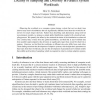Free Online Productivity Tools
i2Speak
i2Symbol
i2OCR
iTex2Img
iWeb2Print
iWeb2Shot
i2Type
iPdf2Split
iPdf2Merge
i2Bopomofo
i2Arabic
i2Style
i2Image
i2PDF
iLatex2Rtf
Sci2ools
ICS
2007
Tsinghua U.
2007
Tsinghua U.
Locality of sampling and diversity in parallel system workloads
Observing the workload on a computer system during a short (but not too short) time interval may lead to distributions that are significantly different from those that would be observed over much longer intervals. Rather than describing such phenomena using involved non-stationary models, we propose a simple global distribution coupled with a localized sampling process. We quantify the effect by the maximal deviation of the distribution as observed over a limited slice of time from the global distribution, and find that in real workload data from parallel supercomputers this deviation is significantly larger than would be observed at random. Likewise, we find that the workloads at different sites also differ from each other. These findings motivate the development of adaptive systems, which adjust their parameters as they learn about their workloads, and also the development of parameterized workload models that exhibit such locality of sampling, which are required in order to ev...
Global Distribution | ICS 2007 | Localized Sampling Process | Theoretical Computer Science | Workload |
| Added | 08 Jun 2010 |
| Updated | 08 Jun 2010 |
| Type | Conference |
| Year | 2007 |
| Where | ICS |
| Authors | Dror G. Feitelson |
Comments (0)

